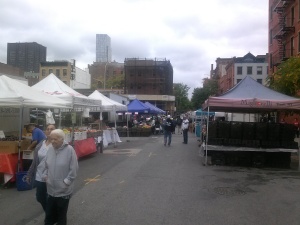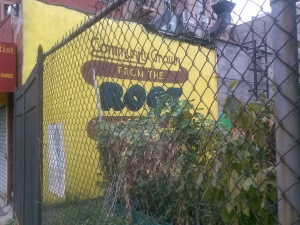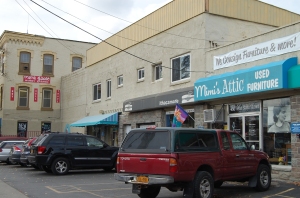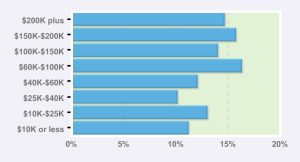
I left my apartment this morning with the intention of interviewing some people in the community to get a clearer picture of the major issues and changes that have taken place in East Harlem. I am particularly interested in learning how people feel about their access to nutritious food and whether or not the community is making progress in areas of sustainability. I’m also keen to hear what people think of sustainability as a modern phenomenon or simple way of living. Walking the streets, I followed my gut to seek out the people who appeared to embody the culture and way of life in East Harlem. These interviews are the accounts and reflections of people who have watched and personally experienced this community evolve over the past 20-50 years.
William “pepsi man” has been living in East Harlem for over 30 years. 8 AM on a Monday morning, William is sitting on a bench in front of the Thomas Jefferson Projects, smoking a cigarette. He was unsure how to answer my question of sustainability. In an attempt to guide his thinking, I made a rookie journalist mistake by giving too much guidance and linking sustainability to climate change. His response, however, was genuine and real. “Ten years ago, it was colder at this time of year. It should be colder now. And we should be getting more rain.”
Some of the changes William has seen occur in the community are that there are “more stores, less empty buildings, less burnt out buildings, less filth.” He remembers people chilling outside the projects, drinking 40s and tossing the bottles in the street. “ You couldn’t walk around here and not step on broken glass. You could get away with a lot more back then. You could practically smoke weed right in a cop’s face.” Now there is a visibly strong police presence around the project buildings and throughout East Harlem. Last month, 3 men were shot and killed in Jefferson Park. Police have been patrolling the park every night, making sure no one is there after the park closes. The policemen that patrol the area are mostly minorities.
The biggest problem in the community, according to William, is gun violence. “The younger generation needs to stop all this killing. We used to fight with these (holding up his fists).” When two people would get in a fight, he said, they’d go separate ways afterwards and that would be it. “These days everyone got something to prove.” Apparently someone in his building was shot and killed after beating another guy in a fight the night before. But that’s only half the problem. Williams see police gun control as a major issue as well. “The police always got a line, ‘shoot first, ask questions later’– that ain’t right.” Bringing up the topic of Miami’s police using rubber bullets, he asks “Why can’t they do that here?”
In a report from April 2013 by the NYC Department of Health and Mental Hygiene, the rate of firearm assault hospitalization among 15-24 year olds in East Harlem was 80.7 per 100,000, more than double the citywide average. Based on its population, East Harlem has the second highest death rate in New York City (Firearm). An article from DNAinfo explains how “Police and community leaders attribute much of the violent crime to youth gangs, which are mainly clustered in the neighborhood’s public housing projects.” (DNAinfo)
On the topic of access to nutritious and affordable food, William said “it’s alright.” He acknowledged that people can get nutritious food if they want, but there are so many more stores selling junk for much cheaper. The bodegas clearly outnumber the grocery stores. I asked him if he thought that more people would eat healthier if there were healthier options in the bodegas or they’d still go for the junk food. “If more options were there for people, they might eat healthier, he said.” In his opinion, people don’t really make serious changes in their lifestyle until it becomes a necessity. Despite the fact that William was diagnosed with diabetes 9 years ago, he says he doesn’t have any episodes, and so continues to eat greasy food and sugary treats.
According to a report from the East and Central Harlem District Public Health Office, about 31% of adults in East Harlem are obese, in contrast to the citywide rate of 22%. About 13% of adults in East Harlem have diabetes, compared with 9% of adults citywide. One of the key findings in the report is that Bodegas are more abundant than supermarkets in East Harlem, comprising 2 in 3 food stores as compared with 1 in 3 food stores in the Upper East Side (Healthy Food).
Deborah has been a resident of East Harlem for 17 years. I find her sitting on a bench in Jefferson Park, watching me walk towards her. To her, sustainability is the recent push toward healthier living. “It’s good that people are smoking less, eating less meat, more fruits and vegetables.” A 2006 health profile on East Harlem, conducted by the NYC Department of Health, shows that East Harlem ranks below average for most health indicators, as compared with 41 other NYC neighborhoods. And nearly one-third of adults in East Harlem consider themselves to be in fair or poor health (Health Profile).
Like William, Deborah talks about the heavy police presence in the area. “They’re always there on the corner with their flood lights.” We both look toward the corner at 1st ave and 112th street. There are two cops standing next to a floodlight. It’s 9 AM, and the flood light is on full power. She doesn’t like it. “It’s like we’re always being watched.” Coincidentally, she also sees fighting on the rise. “The other day, I saw two guys fighting in the street. I stopped to ask someone what happened. They were fighting about a metrocard. That’s New York though. Some people fight about metrocards. Some fight about parking.”
Deborah loves Harlem for it’s history, and a major problem she sees happening in the community is the threat to its culture. The threat, she says, comes from the luxury apartments being built around the community. “You know there’s an old fire tower in Marcus Garvey Park. They want to tear it down. These white people come in here and just…” She trails off. I tell her I understand, that there’s a difference between people coming here and assimilating and- “obliterating the culture!” she declares. A Business Insider article from 2013 indicates that the number of self-identified whites and Asians in East Harlem has doubled over the past 20 years. “Under a controversial NYCHA plan, the cash-strapped agency now proposes to lease public space in the project to private developers to build luxury housing — 20% of which must be designated for low-income families” (Business Insider).
The notion of food security is a critical one for Deborah . “I wouldn’t be here without the pantries. You wanna talk about sustainability. The pantries sustain me.” For Deborah, having access to any food is a blessing. “Harry, I’m po’.” In East Harlem, the percent of residents living below the poverty level is nearly twice as high as the rest of Manhattan and NYC overall (Health Profile).
Mrs. Velez grew up in East Harlem, and has been working at La Marqueta for 43 years. I arrived at La Marqueta for the first time and found a small market under the train tracks at Park avenue and 116th street. There were only 3 shops open in the market. Like Deborah, Mrs. Velez connects sustainability to public health. “Well they got the farmers’ markets in this area– it’s a very good idea. They show people how to use the greens. Showing people how to be healthier. That’s a very good thing to do.”
Mrs. Velez seems to think the community hasn’t changed much over the years. Yet she expresses strong opinions about the state of La Marqueta. “This market used to stretch down to 111th street. There was a fish market, a meat market, groceries, fruits, and vegetables. We don’t have this anymore.” We both look around, confirming the fact that this once-great market is not what it used to be. The reason for La Marqueta’s downfall, according to Mrs. Velez, is that there are too many supermarkets in the area. “The supermarkets took the business here, and instead of promoting the market, they say they’re going to rebuild it, but not in the same way that it used to be.” Mrs. Velez claims that they’re going to “incubate” La Marqueta. “They’re going to re-create the market, but it’ll be with food from outside businesses. La Marqueta is gone.” According to nydailynews, city council is spending 3 million dollars to upgrade La Marqueta and “reopen with a makeover” (La Marqueta).
Despite Mrs. Velez’s bleak predictions for her business and La Marqueta, she doesn’t see food security as a problem in the area. “People on welfare get vouchers to get all those greens at the market.” She then named all those big supermarkets as the places where people can get fresh produce. “You can get fresh fruits and vegetables in Costco, Pathmark, Fine Fare.” It’s obvious that Mrs. Velez feels a deep connection to the market where she’ s worked for 43 years, but she seems to have accepted that La Marqueta as she knows it is gone. There’s more healthy food in the supermarkets, and she agrees that “The fruits are fresh and good at the Farmers’ Market.” There are four farmers’ markets in East Harlem, and food stamps are accepted at all of them (Farmers’).

After the interview with Mrs. Velez, I reconsidered my expectations for what areas of sustainability the interviewees might address. In retrospect, I wish that I had given them a bit more guidance on the question of sustainability. I would have liked to hear their opinions on the topics of recycling, renewable energy, climate change, and overall resource conservation. I suppose that being a first time interviewer in a new environment, I took a more passive role, wanting to maintain fairness in my journalistic endeavor and avoid influencing the interviewee too much. But in doing so, I think that I missed an important interviewing tip, “Be Clear on what you Want.” Well, you live and you learn.
On the other hand, I did gain a good deal of insight into the more prevalent issues in East Harlem, at least in the minds of its residents. It does seem to be a common phenomenon that more poverty stricken humans are less focused on recycling and climate change and more caught up in just trying to survive. In my final interview for this project, I spoke with a older gentleman sitting on an upside bucket in front of an apartment building next to an auto repair shop. He prefers to be identified as the Super of the building.
The Super on east 112th street has been living there since 1968. The most dramatic change he’s seen in the community is the decline of drugs. “In the 70s, there was trafficking all throughout this area.” Despite his assurance that “drugs have been minimized by 90%” he still considers it to be one of the biggest problems in the area. “It’s gotten better over the years, but still compared with the rest of New York, drugs are a problem here, says Super.” A google search of “Drugs East Harlem” confirms the Super’s account, showing numerous links to stories of police cracking down and arresting drug dealers in East Harlem.
Unanimous among my interviewees is the feeling that people do have access to healthy food in East Harlem. “If people don’t have food, they can go to the churches. They can get food stamps.” The Super’s opinion on the matter of La Marqueta is that it has declined as a result of “people from Korea planting food markets every 10 blocks from way down all the way up to 125th. That killed La Marqueta. The market was still functioning when you had supermarkets around.”
Sustainability, according to the Super, “has to do with the food that people eat and the ability to get that food.” He maintains that it isn’t much of an issue in East Harlem. “I don’t see any major catastrophe in health. For the Super, the matter of food security comes down to whether or not a person wants to be helped. “The help is available in this area and throughout New York.” According to the nyc.gov page for Manhattan Food Sources, there are 12 establishments working to feed impoverished peoples in need of food. To name a few: New Beginning Ministry Soup Kitchen, Beacon Youth and Family Food Pantry, and Yorkville Common Meals all accept walk-ins (Food Sources).

Roaming the streets of East Harlem, one might be surprised to actually find a plethora of sustainable practices being conducted. Every Thursday from 8 AM to 4 PM, there is a farmer’s market right in the heart of East Harlem at 104th and 3rd ave. The market offers local produce, juices, and baked goods and accepts food stamps. Behind one of the buildings next to the market is a generously sized community garden. Similarly, there are two vegetable gardens outside the Thomas Jefferson projects. Also, along the 115th street side of the TJ projects are 6 newly planted young trees. On 3rd ave and 110th, there is a grocery store with Farmer’s Market written in big letters across the canopy out front. The store seems to be jointly owned by Mexicans and Koreans. This grocery store offers a wide variety of produce for very affordable prices and even cage free eggs. At Park Ave and 116th, one block north of La Marqueta, you will find the Urban Garden Center. There they sell all kinds of different plants, trees, and gardening equipment. There are also signs and posters up for sustainability-related events, including a Youth Marqueta, where kids can get involved with and educated about local, organic food.

Aside from the sustainability problems in East Harlem that exist in just about every neighborhood throughout NYC, there doesn’t seem to be too much un-sustainability happening. Of course, the cars far outnumber the bikers. But you will find hundreds of people walking around the main blocks at just about any time of day. There are a handful of empty lots and store fronts scattered throughout the area. One would be hard-pressed to find any solar panels or wind turbines. There is however, an excessive amount of scaffolding structures throughout the community. They look shabby, they impede the growth of young trees, and apparently they also hamper security. Below is a link to a nydailynews article, entitled “Tear them down! Tenants at Thomas Jefferson Houses say scaffolding hampers security.”
The good people outnumber the bad apples here in East Harlem. I can say that with conviction. There is an abundance of charitable organizations, supported and run by community members for community members. This is a strong community with a vibrant and diverse culture. Surely East Harlem has its problems, but the statistics can’t show you the kinds of things you’d learn from walking the streets and talking to locals.

http://www.nydailynews.com/new-york/uptown/scaffolds-enemy-e-harlem-article-1.1869819
http://www.businessinsider.com/new-yorks-east-harlem-gentrification-photos-2013-9?op=1
http://www.nyc.gov/html/doh/downloads/pdf/dpho/dpho-harlem-report2007.pdf -Healthy Food
http://www.nyc.gov/html/doh/downloads/pdf/data/2006chp-303.pdf -Health Profile
http://www.nyc.gov/html/om/pdf/2013/firearms_report.pdf -Firearm
http://www.nydailynews.com/blogs/dailypolitics/upgrades-coming-east-harlem-la-marqueta-melissa-mark-viverito-announces-blog-entry-1.1895908 – La Marqueta
http://www.nyc.gov/html/doh/downloads/pdf/cdp/health-bucks-poster-mn.pdf -Farmers’
http://www.nyc.gov/html/dhs/downloads/pdf/crh_food_ny.pdf – Food Sources
http://www.dnainfo.com/new-york/crime-safety-report/manhattan/east-harlem -DNAinfo








